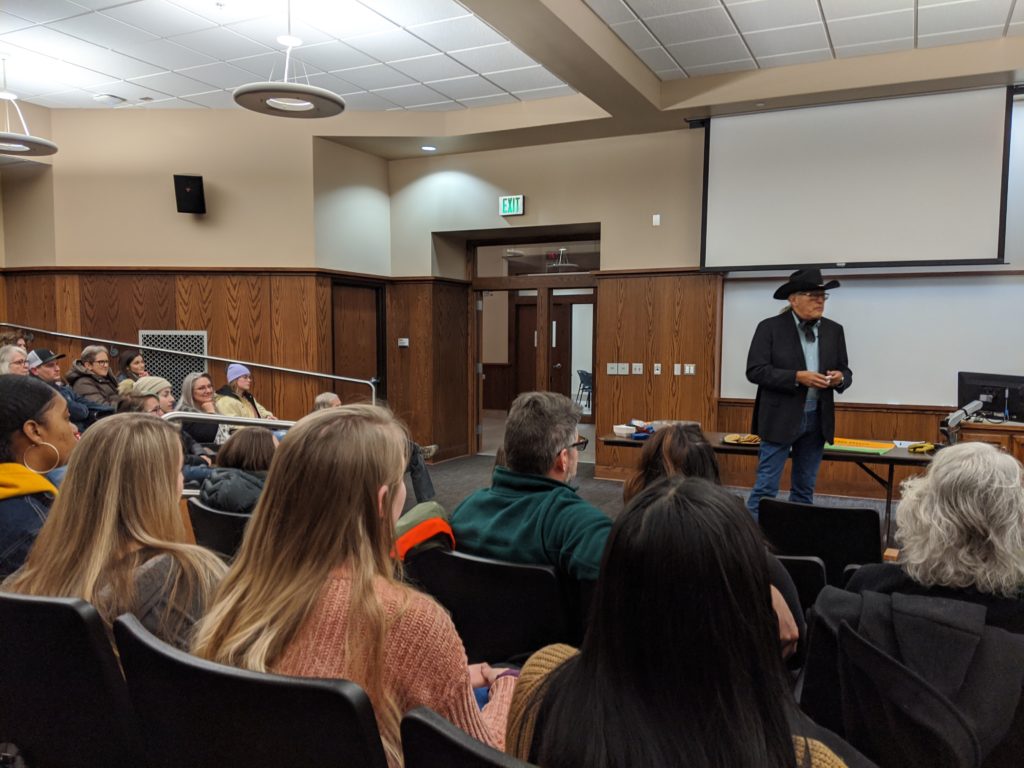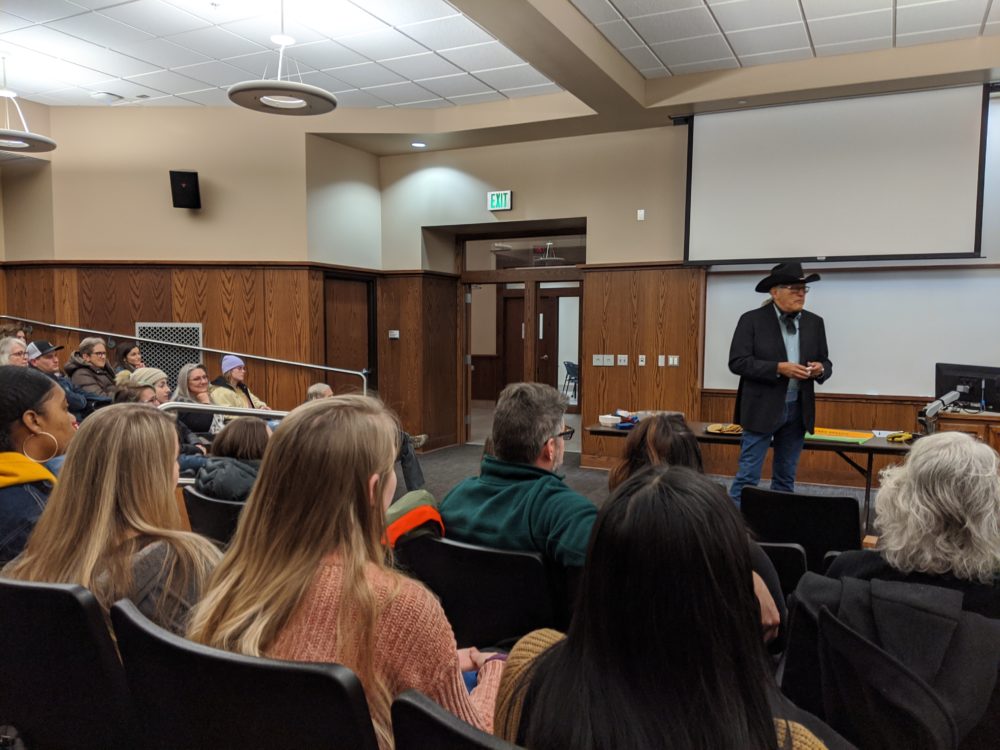Dr. Gerard Baker tells the story of his career to a packed lecture hall

Dr. Gerard Baker speaks to a room full of people in Minard Hall about his career in incorporating Native American heritage and history into the NPS programs and visitor centers.
Dr. Gerard Baker had a warm North Dakota State welcome on Thursday, February 27th being greeted by a packed lecture hall for his presentation Yellow Wolf: A National Park Service Superintendent’s Story.
Dr. Baker stood over six feet tall; wearing cowboy boots and a hat. He opened up the presentation with his story of growing up in North Dakota on Fort Berthold Reservation, located forty-five minutes East of Watford City. He remembers his first time meeting a park ranger thinking to himself, “I don’t want to be that guy” after seeing the ranger get bucked off one of the horses that he and his family owned
Growing up on the reservation was exhilarating, with over twenty horses to ride on their ranch, but at times according to Dr. Baker, growing up was fraught with hardships. Dr. Baker grew up in a time when the government still controlled Native Americans’ way of life. “There was the existence of the Bureau of Indian Affairs (BIA) and every time we wanted to go off the reservation we had to report to them, tell them (the BIA) where we were going, who we were going with and how long we would be gone.”
It wasn’t until The American Indian Religious Freedom Act, enacted by congress in 1978, that allowed Native Americans the right to practice sacred ceremonies, speak their native language and practice aspects of their religion that were before this ruling, prohibited.
After high school Dr. Baker left to pursue a degree, eventually graduating with a Bachelor’s in Criminology and Sociology. His first job after college following the chosen track of law enforcement was “trying to track down sellers of heroin” and bring them to justice in Humboldt County, CA.”
From there Dr. Baker’s career went from a law enforcement department serving the County to being a National Park Ranger, which at the time was seen as a role that acted as law enforcement in the National Parks Service.
Dr. Baker had his start in the NPS in “1979 at the Knife River Indian Villages National Historic Site. He continued his work at Fort Union Trading Post National Historic Site, Theodore Roosevelt National Park, Little Big Horn Battlefield National Monument, Chickasaw National Recreation Area, Lewis and Clark Historic Trail and finally, Mt. Rushmore National Memorial.” All in all, he spent “33 years in the National Park Service.”
Not only did he serve as law enforcement but later in his career at Little BigHorn Battlefield had the opportunity to start telling a different side of the story; “the Indian side of the story.” It was never his intent to view other sides of the story as wrong, but to give a fuller and richer history of the “people that were here before and after Lewis and Clark explored North America.”
At LittleBighorn, Dr. Baker recounts receiving death threats against his life and his family after hiring people who were Native American in turn, allowing them to widen LittleBighorn’s educational programs and exhibits. The new NPS employees were able to communicate and tell the stories of specific people who fought on the battlefield and were passed down through the tradition of oral storytelling.
Dr. Baker was put in charge of organizing the Lewis and Clark Bicentennial Commemoration that took place from 2003 to 2006. “The hardest part was bringing tribes together to encourage them to teach others of their heritage and history,” showing the disdain and fear from generations of tribes being mistreated, killed and stripped of their original homelands.
It was at a meeting like this, “Where I introduced a grand-plan to the tribes and talked about how much funding we have, how the public is going to get involved and what we’re going to do. After asking if there was any questions, an elder in the back row raised her hand and said ‘I don’t trust you, you’re nothing but an Indian Bureaucrat with braids.'” Dr. Baker said he looked at her and responded with, “Yes I am, and because of that I want you to get involved and teach the tourists who are going to be passing you by if otherwise.
After multiple trips to Native American tribes, Dr. Baker wanted to encapsulate the entire story of America, the good and bad. That’s when he found himself walking into a bar in Idaho known to be where the leader of the KKK in the state spent his time. “After asking him to be a part of the Lewis and Clark Bicentennial and the importance of every story being included they gave me one minute to get out of the bar, and that I did.” So in the end, they denied being included in the Bicentennial.
After a successful three year “commemoration of the Lewis and Clark exploration,” Dr. Baker then moved onto other locations in the NPS. “Me and my wife, Mary-Kay, moved over twenty times in our careers with the NPS,” he mentioned. Their last stop was Mt. Rushmore where he served as the Superintendent of the Park. During his time there, where he included a replica of a structure that the Lakota Sioux would build and use as their dwelling.
He wrapped up his speech reminding us to live closer to the land and “that we should take care of what we have because when it’s gone, it’s gone.”
Dr. Baker and his wife Mary-Kay now live in Montana “in his own, personal National Park,” where he’s currently working toward re-wilding the land to let the Bison roam once again.
The word “Indian” is used only in quotations, recording exactly what Dr. Baker said during his presentation.
